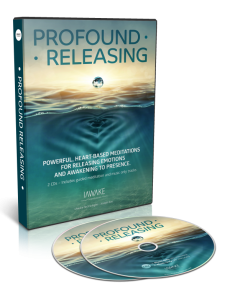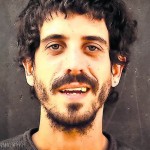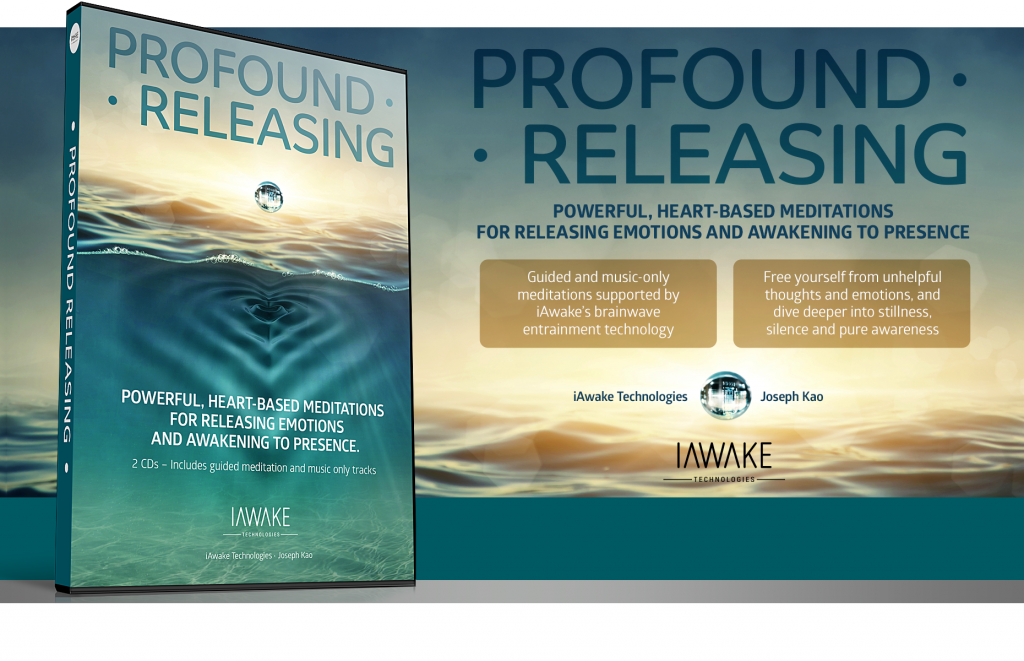What is Emotional Releasing and How Can I Let Go?
Javi: Today we are lucky to have with us Joseph Kao, the creator of iAwake’s latest release Profound Releasing. As it says in the description, “It’s a multi-layered, guided meditation with advanced brainwave entrainment technology, designed to help you let go of old, rigid emotional patterns and rediscover your natural spontaneity, energy, and vitality … and to open your heart and allow a deep sense of love and compassion to flow through your body and mind.” It’s 120 minutes, so it’s a lot of work. I know Joseph has been working on this like mad, especially because he’s really busy with many things. So, Joseph, welcome.
 Joe: Thank you, Javi. It’s great to be here.
Joe: Thank you, Javi. It’s great to be here.
Javi: Could you please tell us a bit about your background?
Joe: Sure. I work as a hypnotherapist, seeing people one-on-one. That’s been my primary work since about 2005. It’s also been my passion for a long time. Even as a teenager, I was very drawn to exploring things like brainwave entrainment, meditation, and processes that create experiential change—it has always been about the actual, tangible experience of changing something in your consciousness, changing something in your state and the way you feel, and really sensing the difference, both for myself and for other people.
One thing I’d like to say leading up to talking about Profound Releasing is that when I first started out, much as I was drawn to meditation and various forms of self-hypnosis and autogenic training, I was not the kind of person who immediately transcended to the astral plane and experienced spiritual fireworks or anything like that. I started out being quite cerebral, a bit dissociated maybe, and a lot of the work that I needed to do on myself was about getting in touch with the body and grounding the work that I do in my body and in my heart rather than immediately trying to aim for transcendence.
 Something that really resonated with me in the book A Path with Heart by Jack Kornfield was that some meditators, whether consciously or not, tend to focus on (in the chakra system) the third eye and the higher chakras, when what we need to do first is to go deep into our bodies and work out all that’s grounded in the physical in human beings—this might be issues with the heart or issues to do with the base chakras, the sexual energy. We mustn’t neglect this in any spiritual practice; we need to be working in a multi-layered way.
Something that really resonated with me in the book A Path with Heart by Jack Kornfield was that some meditators, whether consciously or not, tend to focus on (in the chakra system) the third eye and the higher chakras, when what we need to do first is to go deep into our bodies and work out all that’s grounded in the physical in human beings—this might be issues with the heart or issues to do with the base chakras, the sexual energy. We mustn’t neglect this in any spiritual practice; we need to be working in a multi-layered way.
As I said, when I first began to meditate, it was not an especially profound experience. I was one of those people—and I know that there are plenty of people who have this experience—who felt “Gosh, I’m a bit bored, my mind’s chattering… Not much is happening. Am I doing this right?”
So, one of the things I wanted to do in developing a guided meditation product was create something that would speak to people who, when they try to meditate, find their mind wandering and themselves getting a bit lost, not sure if they’re doing it right. (Well, not just the people who are beginning, because actually, we’ve had amazing feedback on Profound Releasing that it also helps very experienced meditators release emotional patterns they needed to let go of. So, it can add to your practice at many different stages of your development.)
I remember reading some fantastic tips for releasing on the iAwake site a year or two ago, processes for being able to go inside and let go of emotional patterns and blocked energy that are causing a sense of contraction in the body and in the mind. I know from experience that these kinds of processes work very well, and at the same time, that some people find it hard, initially, to take themselves through processes like this, because there’s a certain art to self-directing your own meditation, especially if you’re doing a process like releasing.
 So, I really wanted to create a product—a guided meditation experience—that would help people tangibly experience the benefits of releasing, so people who normally find that their mind wanders a bit can take themselves through the releasing process as well. My aim is for this recording to also function as a training system: It’s not that people need to be dependent on the words, because after you’ve taken yourself through the process multiple times, you develop neuropathways, and it becomes easier and easier to do on your own.
So, I really wanted to create a product—a guided meditation experience—that would help people tangibly experience the benefits of releasing, so people who normally find that their mind wanders a bit can take themselves through the releasing process as well. My aim is for this recording to also function as a training system: It’s not that people need to be dependent on the words, because after you’ve taken yourself through the process multiple times, you develop neuropathways, and it becomes easier and easier to do on your own.
That’s why I created a 40-minute extended, verbally-guided meditation, as well as a 20-minute version of that, and the other two tracks are simply the music with the brainwave entrainment. Listening to the music tracks, you are anchored in all of the processes that you’ve been doing with the verbal guidance, and then you start to find that you’re doing it by yourself. It becomes a training that’s more and more something you’ve internalized, that you can do in your own way and adapt in your own way. It becomes a resource that you can draw on anytime, anywhere, because it’s something that your nervous system, your mind and body, become very familiar with.
Javi: That’s beautiful. I really love the place you work from and your aims for the track. Joe, how would you explain to a client who didn’t know much about this, what emotional releasing is about and how it can be done?
Joe: Well, first of all, all human emotions have a function; they have a healthy way they can be expressed. The goal of any releasing work, the goal of any meditation, is never about eliminating emotions or getting rid of them. What we’re talking about here is the way people get stuck and locked in a particular emotional pattern―whether it’s anxiety, anger, resentment, regret, sadness, loss, grief, or depression―that isn’t serving them. A huge part of this is the process of resistance―fighting something, feeling that you shouldn’t be feeling the way you do or that things aren’t the way they should be, and that you’ve got to hold onto the tension inside. That’s where people seem to get stuck.
 The experience of emotional releasing is the feeling where something that used to really trouble you, that used to wind you up or plague you with a particular doubt or worry, at some point, over the years―you’ve transcended it. You’ve moved beyond it, and when you look back, it was a younger you who used to be caught up in that pattern, but now you’ve let it go. You’ve moved on, and not through a process of battling or fighting it ―you’ve simply outgrown it. You can look back at that younger you, even if you look back at the five-year-old you who was afraid to go to sleep at night because of monsters in the wardrobe or witches at the window, and you can feel compassion, maybe a sense of humor about it. “Gosh, that was me back then.” But, you’ve let go and moved on from that.
The experience of emotional releasing is the feeling where something that used to really trouble you, that used to wind you up or plague you with a particular doubt or worry, at some point, over the years―you’ve transcended it. You’ve moved beyond it, and when you look back, it was a younger you who used to be caught up in that pattern, but now you’ve let it go. You’ve moved on, and not through a process of battling or fighting it ―you’ve simply outgrown it. You can look back at that younger you, even if you look back at the five-year-old you who was afraid to go to sleep at night because of monsters in the wardrobe or witches at the window, and you can feel compassion, maybe a sense of humor about it. “Gosh, that was me back then.” But, you’ve let go and moved on from that.
I think there’s a universal experience that people have when they’ve let go of something or when they’ve forgiven someone, when that tension in the abdomen or the solar plexus of, “I can’t believe you did that! How could you have done that?” softens… and you begin to see that person again from a place of compassion, warmth, kindness, and forgiveness. There’s a feeling inside of softening, letting go―of release.
It helps so much when you are able to do this from a place of compassion, with patience and kindness towards yourself, where you stop in the middle of a situation that has been getting you unhealthily wound up or plagued by a doubt or worry, and rather than fight it, you welcome it with kindness in your heart. You say, “Ah, there’s that pattern again.” You breathe into it. You allow yourself to feel it. Through making that your practice, you find that these sorts of patterns begin to soften and dissolve.
That’s been my experience time and again doing this work: when you welcome an emotion fully, when you welcome a thought, a troubling sensation, with compassion, patience, and kindness, the sensation itself softens, and you’re treating yourself in that moment with decency, humanity, and kindness. This is a beautiful practice to have both in how you treat yourself and how you treat others.
This is fundamentally what I’d like people to learn and experience through this recording―to let the recording be just like a ladder, which when you have used it enough and got to where you need to be, you might not need anymore. You can listen to it repeatedly over a period of weeks and months, and then there comes a point when you find that you can do it by yourself. You might want to return to it from time to time, if you’re experiencing a particular stirring up of painful emotions. But, generally speaking, it becomes something that you know how to do yourself because you’ve taken yourself through the process enough times. Profound Releasing is about training an attitude, a way of relating to yourself with kindness, from a sense of peace, and of course, opening and broadening and expanding your awareness in a way that can transcend and include what has been the problematic pattern.
Stay tuned for Javi and Joe’s discussion of the pioneering brainwave entrainment and soundscape of Profound Releasing in an upcoming blog.
__________________________________________________________________________
Joseph Kao is a hypnotherapist and a solution-focused therapist with a private practice in London and Cambridge, UK.
He has been the head scriptwriter for over eight hundred professional hypnotherapy recordings, and he works as a teacher and a course-developer on psychotherapy training courses.
Joseph has been fascinated by philosophy, meditation, and brainwave entrainment technology since he was a teenager, and he’s had a daily meditation practice since 1998.
___________________________________________________________________________
 Javi Otero is iAwake’s Chief Technology Officer and is introducing new and experimental entrainment protocols developed through his ongoing research on further harnessing the power of sound energy. He also offers experiential support with iAwake products, sound technology expertise, and sometimes lends his lyrical hand at writing for iAwake.
Javi Otero is iAwake’s Chief Technology Officer and is introducing new and experimental entrainment protocols developed through his ongoing research on further harnessing the power of sound energy. He also offers experiential support with iAwake products, sound technology expertise, and sometimes lends his lyrical hand at writing for iAwake.
Photography by Javi Otero
__________________________________________________________________________
Adapted from iAwake Technologies’ free, weekly teleconference call on September 16, 2015.
Join our weekly calls!
To receive information on how to join the weekly iAwake coaching calls, sign up for the free meditation download and you’ll be put on the email list. You can also access the phone-in information on our Teleseminar page.
___________________________________________________________________________
Leave a Comment
You must be logged in to post a comment.



Leave your comments below